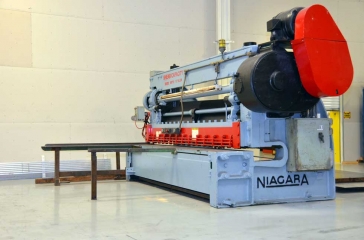Sheet Metal Shear
Shearing is the most effective way for our steel fabricators and aluminum fabricators to make long straight cuts up to 12' wide, for up to 0.375" thick mild steel, 0.25" aluminum, and 0.25" stainless steel.
Shearing is most often used in conjunction with another process such as laser cutting or turret punching. This is the most effective way for our steel fabricators and aluminum fabricators to make long straight cuts up to 12' wide, for up to 0.375" thick mild steel, 0.25" aluminum, and 0.25" stainless steel.
The machine used is called a squaring shear, power shear, or guillotine. The machine may be foot powered (or less commonly hand powered), or mechanically powered. It works by first clamping the material with a ram. A moving blade then comes down across a fixed blade to shear the material. For larger shears the moving blade may be set on an angle or "rocked" in order to shear the material progressively from one side to the other; this angle is referred to as the shear angle. This decreases the amount of force required, but increases the stroke. A 5 degree shear angle decreases the force by about 20%. The amount of energy used is still the same. The moving blade may also be inclined 0.5 to 2.5°, this angle is called the rake angle, to keep the material from becoming wedged between the blades, however it compromises the squareness of the edge.
As far as equipment is concerned, the machine consists of a shear table, work-holding device, upper and lower blades, and a gauging device. The shear table is the part of the machinery that the workpiece rests on while being sheared. The work-holding device is used to hold the workpiece in place and keep it from moving or buckling while under stress. The upper and lower blades are the piece of machinery that actually do the cutting, while the gauging device is used to ensure that the workpiece is being cut where it is supposed to be.
The design of press tools is an engineering compromise. A sharp edge, strength and durability are ideal, however a sharp edge is not very strong or durable so blades for metal work tend to be square-edged rather than knife-edged. Typical workpiece materials include aluminum, brass, bronze, andmild steel because of their outstanding shearability ratings, however, stainless steel is not used as much due to its tendencies to work-harden.
Other types of geometrical possibilities include the squaring shear, angle shear, bow-tie shear and bar shear. All of these have many different uses and are all used regularly in certain manufacturing fields.


